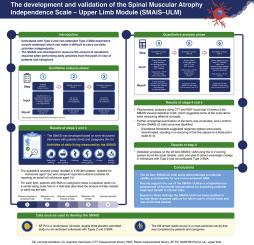Journal of the Neurological Sciences ( IF 4.4 ) Pub Date : 2021-01-13 , DOI: 10.1016/j.jns.2021.117318 Dylan Trundell , Anne Skalicky , Hannah Staunton , Asha Hareendran , Stephanie Le Scouiller , Louise Barrett , Owen Cooper , Ksenija Gorni , Tim Seabrook , Sangeeta Jethwa , Stefan Cano

|
Background
The amount of assistance required to perform daily activities for individuals with Type 2 and non-ambulant Type 3 spinal muscular atrophy (SMA) is often cited as meaningful for quality of life, and important to routinely assess.
Methods
The SMA Independence Scale (SMAIS), a patient-reported outcome measure for individuals with SMA aged ≥12 years, and an observer-reported outcome measure for caregivers of individuals aged ≥2 years, was developed and evaluated in two phases. In Phase 1, 30 draft items were developed following review of the literature. Semi-structured interviews were then conducted with individuals with SMA and caregivers to establish content validity, resulting in a 29-item measure. In Phase 2, classical test theory and Rasch measurement theory methods were used to examine the cross-sectional and longitudinal measurement performance of the SMAIS in two independent datasets.
Results
Phase 1 qualitative findings supported the relevance, acceptability, and comprehensibility of 29 items. In Phase 2, psychometric analyses indicated that the five response options were poorly discriminated and were thus collapsed to three options for subsequent analyses. Items showed statistical misfit, implying that the SMAIS was not assessing a single underlying construct. Based on conceptual evaluation of the items, and assessment of item performance, a more targeted 22-item upper limb score was derived. Reliability and validity analyses confirmed acceptable measurement properties of this score.
Conclusions
Qualitative and quantitative analyses support the use of the 22-item SMAIS–Upper Limb Module in individuals with Type 2 and non-ambulant Type 3 SMA, aged ≥2 years.
中文翻译:

SMA独立量表-上肢模块(SMAIS-ULM)的开发:适用于2型和非流动性3型SMA个体的新型量表
背景
通常认为2型和3型非移动性脊柱肌肉萎缩症(SMA)的个体进行日常活动所需的帮助量对生活质量有意义,并且对例行评估很重要。
方法
SMA独立性量表(SMAIS)是分两个阶段开发和评估的,它是针对SMA≥12岁的患者进行患者报告的结局指标,以及针对≥2岁的SMA进行照护者的观察者报告的结局指标。在第一阶段,在对文献进行审查后,制定了30项草案。然后,对患有SMA和看护者的个人进行半结构化访谈,以建立内容效度,得出29项指标。在阶段2中,经典测试理论和Rasch测量理论方法用于检查两个独立数据集中SMAIS的横截面和纵向测量性能。
结果
第一阶段的定性研究结果支持了29个项目的相关性,可接受性和可理解性。在第2阶段,心理计量学分析表明,对五个响应选项的区分不佳,因此将其折叠为三个选项,以便进行后续分析。项目显示统计不匹配,这表明SMAIS并未评估单个基础结构。基于项目的概念评估和项目绩效评估,得出了更具针对性的22个项目上肢评分。可靠性和有效性分析证实了该分数的可接受的测量特性。
结论
定性和定量分析支持对年龄≥2岁的2型和非流动性3型SMA患者使用22件SMAIS-上肢模块。



























 京公网安备 11010802027423号
京公网安备 11010802027423号